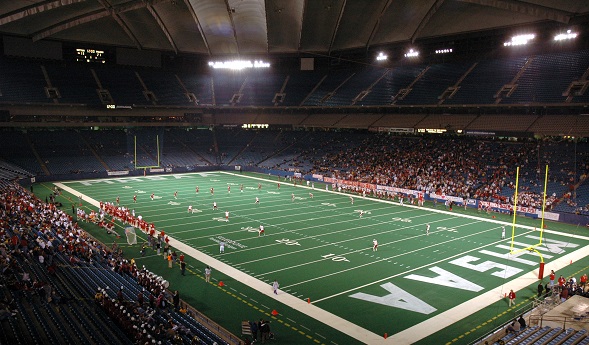
Farewell Silverdome; Our Memories Live On
By
Ron Pesch
MHSAA historian
November 28, 2017
Farewell Pontiac Silverdome.
In early December, more than 15 years after the Detroit Lions played their last game beneath its air-supported Teflon-paneled roof, the “Dome” will take a last breath and then depart.
Finally.
The last few years have been cruel to the stadium that was once a gem and the home of dreams.
The Lions arrived at the newly opened “Pontiac Metropolitan Stadium” (or “Ponmet” as it was called by enthusiasts of the new structure) in August 1975. It was renamed “Pontiac Stadium” later in the year by the city council, and in October of 1976 the Pontiac council again re-christened the building as the “Pontiac Silverdome.”
“We feel the new name better conveys the image of our facility,” said Charles McSwigan, Jr., stadium executive director, at the time. “It certainly lets everyone around the country know we have a modern year-round domed stadium.”
The move was primarily marketing motivated. “The other three giants, Super, Astro and King, get all the publicity,” added McSwigan, further explaining the change. “Promoters call them, but they don’t even come near us.”
Launched in 1975, the MHSAA football championship games were played outdoors at college stadiums that first year on the Saturday before Thanksgiving. While deemed a success, the games were played at two different sites. That had presented challenges.
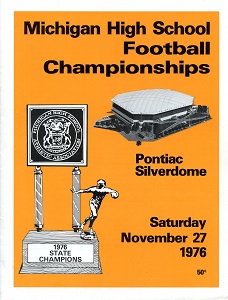 Following that first year, consideration was given to the new structure in Pontiac.
Following that first year, consideration was given to the new structure in Pontiac.
“There are some problems,” remarked Al Bush, MHSAA executive director, explaining the logistics of a possible move to the NFL stadium. “For instance, it would be difficult to play four games on the same day. We would have to start early in the morning, and the last game would have to start late at night.”
Competition for attendance with various events, including deer hunting season, and college football – especially the televised University of Michigan-Ohio State game – were factors to be considered. The high school football playoffs were still a new product without a tradition. Finances also were an area of worry. It was estimated that a crowd of between 20,000 and 25,000 would be needed to make the jump economically feasible.
So, it was with great caution and trepidation that the move was made indoors to Pontiac. Initially, the contract was for a single year. The games would be played on the Saturday following Thanksgiving. By all measures, to the delight of all involved, the 1976 championships were a huge success.
“The four state championship games, which were played in the Silverdome in two sessions on Saturday, drew a paid attendance of 29,423 fans,” said Associated Press writer Harry Atkins in a follow-up piece following the games, “bringing smiles of relief and joy to MHSAA Executive Director Al Bush and his assistant, Vern Norris. The attendance figure was almost double the number of fans who turned out last year in ice box-like weather at two sites – Western Michigan University and Central Michigan University.”
With that, a new contract was signed, and for 29 years the city of Pontiac served as home to the MHSAA 11-player football championships. “Goin’ to the Dome” soon became the goal of every high school in Michigan that offered the sport.
Following a 15-10 victory over the Dallas Cowboys in early January 2002, the Lions departed the Silverdome for Ford Field, located in downtown Detroit. The high school Finals stayed put for three more years before moving to Ford Field.
Twelve seasons after following the Lions from Pontiac to Detroit, countless memories and several MHSAA championship game records still stand from those years under the Dome.
Four championship games were played at the Silverdome to close each season from 1976-90. In 1991, the playoffs were expanded to eight classifications and the Finals expanded to eight games over a two-day showcase.
For many across Michigan, those 176 high school state title games were their first live exposure to the building many had only seen on television. For football fans, the MHSAA Finals provided an affordable and unique chance to visit the stadium and watch the game between the 20-yard-lines at ground level. An NFL game, concert, or in later years a Pistons basketball game at the Silverdome was far from an intimate experience for most. Seating 80,311, it was the largest stadium in the NFL until 1997.
For thousands of athletes and coaches, the playing surface was their first exposure to artificial turf. It was an honor to set foot on the field. After all, who didn’t want to run on the same canvas on which Lions legend Barry Sanders painted?
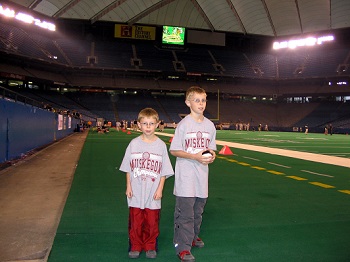 Who can forget the Mill Colemen-led comeback drive to title glory in the final minutes as Farmington Hills Harrison downed DeWitt for the Class B title in 1989, or “The Catch” by Muskegon Reeths-Puffer’s Stacy Starr that broke the hearts of Walled Lake Western players and fans in the final seconds in Class A in 1992? Who remembers the wild 91 points (and 883 yards in total offense) posted in Belding’s 50-41 victory over Detroit Country Day in Class B in 1994, when Belding trailed by 19 points at the half? The combined final score remains the record for most points tallied in a title game by two teams.
Who can forget the Mill Colemen-led comeback drive to title glory in the final minutes as Farmington Hills Harrison downed DeWitt for the Class B title in 1989, or “The Catch” by Muskegon Reeths-Puffer’s Stacy Starr that broke the hearts of Walled Lake Western players and fans in the final seconds in Class A in 1992? Who remembers the wild 91 points (and 883 yards in total offense) posted in Belding’s 50-41 victory over Detroit Country Day in Class B in 1994, when Belding trailed by 19 points at the half? The combined final score remains the record for most points tallied in a title game by two teams.
Farmington Hills Harrison and coach John Herrington won five consecutive finals in Pontiac (1997, 1998, 1999, 2000, 2001), and 12 of their 13 MHSAA Finals titles at the Silverdome. A total of 12 of Detroit Catholic Central’s 17 trips to the Finals meant a bus ride to Pontiac.
One record performance set in the opening game of the 1976 championships still stands in the MHSAA championship record book. With the evolution of the game, it may never fall.
Despite the climate-controlled environment afforded by moving indoors, Crystal Falls Forest Park threw only three passes against Flint Holy Rosary in the Class D title game, completing one for a net -3 yards. By default, that total established a record for pass defense in a title game. It remains the zenith.
Forest Park had little need for the pass that day. The Trojans rolled up 234 rushing yards on 48 carries, including a 74-yard touchdown run off left tackle by all-state running back Marty Ball with 4:36 to play in the first quarter. Less than two minutes later, a fumble recovery by Forest Park’s Charlie Davis was returned 25 yards for a score, and the Trojans led, 14-0. Holy Rosary passed for 204 yards including an 18-yard pass from Ron Fray to Dan Lehoux in the second quarter, but couldn’t overcome that first quarter deficit, falling 14-6. A crowd of 14,879 attended the day’s first session, comprised of the Class D and Class A games.
Other long-standing record performances at the Dome still can be spotted in the record book.
Josh Wuerfel’s 46-yard field goal in the second quarter gave Traverse City a 10-0 halftime lead and aided the second-ranked Trojans’ 24-14 defeat of top-ranked Detroit Catholic Central in the 1988 Class A contest. The kick stood for 28 years as the title game record before finally being exceeded (twice!) at the 2016 championships played at Ford Field. Liam Putz of Grand Rapids West Catholic shattered the mark with a 47-yarder against Menominee in the Division 5 title game, before Ben Fee of Orchard Lake St. Mary’s topped the kick in the eighth game of the weekend. Fee’s 49-yard field goal late in the fourth quarter helped St. Mary’s down Muskegon 29-28 in the Division 3 thriller. The boot was his third field goal of the game. Combined with two extra points, he finished as the Eaglets’ top scorer.
Paul Gross of Jackson Lumen Christi established a new mark for extra points against Livonia Clarenceville in the 2001 Division 5 game, connecting accurately on all seven of his attempts. The record has been matched twice since the move to downtown Detroit.
Nick Williams’ 90-yard touchdown dash on Farmington Hills Harrison’s first play from scrimmage in the 1994 Class A game, a 17-13 victory over Grand Rapids Forest Hills Central, still tops the record book category for longest run play in a title game. An 89-yard TD run by Constantine’s Jim Schragg sits directly behind the Williams’ mark. Schragg rolled up 307 yards in a 34-13 win over Suttons Bay in the 2004 Division 6 game, during the final year at the Silverdome. His total established the pinnacle for rushing yards in a game.
Ravenna’s Benny Clark carried the ball 49 times (including 29 rushes in the second half) for 212 yards as the Bulldogs topped Morenci 30-14 in the 1996 Class C contest. The total, which exceeded the previous mark of 40 set by Dan Lato of Crystal Falls Forest Park in 1977, has yet to be matched or exceeded.
The fastest championship game passing touchdown came 15 seconds into the 2003 Division 5 Final, when Jackson Lumen Christi‘s Tyler Aldridge found wide-open Matt Russell on a reverse pass on the second play from scrimmage. The Titans defeated Muskegon Oakridge 23-0 for the title.
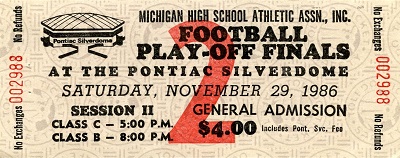 Quarterback Tony Koshar tossed a short pass to Jim Steinman, “who shed a tackler and managed to stay in bounds as he took off for the end zone on a 96-yard scoring play,” as Gobles grabbed a 31-22 upset victory over top-ranked Crystal Falls Forest Park in the 1984 Class D title game. The reception for the longest pass play lasted 24 years before it was finally topped in 2008.
Quarterback Tony Koshar tossed a short pass to Jim Steinman, “who shed a tackler and managed to stay in bounds as he took off for the end zone on a 96-yard scoring play,” as Gobles grabbed a 31-22 upset victory over top-ranked Crystal Falls Forest Park in the 1984 Class D title game. The reception for the longest pass play lasted 24 years before it was finally topped in 2008.
Kirk Williams’ 15 pass receptions for DeWitt against East Grand Rapids in the 2002 Division 3 contest still stand the test of time, as does Brad Johnson’s 87-yard punt return for a touchdown for Schoolcraft against Frankfort in the 1988 Class D championship game.
The 1991 title games saw two defensive marks set, both on the same day. On Saturday, November 30, Rick Marcotte of Lake Linden-Hubbell scooped up a fumble and dashed 79 yards for a touchdown and a new Finals record versus Mendon in Class DD. Less than 16 hours earlier Nate Cierlak of Muskegon Catholic Central had set the mark with a 56-yard return for a TD against Harbor Beach. In that year’s Class CC Final against Negaunee, Jason Livengood of Battle Creek Pennfield set the one mark that statistically can never be topped when he returned a pick-six for 100 yards.
Eight punts by Muskegon’s Jason Crago in the Big Reds’ 16-13 victory over Detroit Martin Luther King in the 1989 Class A title game was unmatched until 2007, when Aaron Hudson of Blissfield equaled the total. On Saturday, Clarkston’s Jermaine Roemer also tied the record in the Division 1 Final.
Between 1976 and 2004, more than 1.5 million fans attended the games in Pontiac, with a peak of attendance of 71,156 in 1995.
Soon the site will be cleared, with plans for redevelopment. Not far down the road, The Palace of Auburn Hills, once home to the MHSAA Basketball Finals and longtime home to the MHSAA Individual Wrestling Finals, will be scrubbed from the earth. Along with them, the structural evidence of the home of countless accomplishments will disappear.
Change is constant, and time moves on. Still those achievements, and several others, live on in the pages of the MHSAA record book, in the memories of those who competed and the recollections of those who played witness.
 Ron Pesch has taken an active role in researching the history of MHSAA events since 1985 and began writing for MHSAA Finals programs in 1986, adding additional features and "flashbacks" in 1992. He inherited the title of MHSAA historian from the late Dick Kishpaugh following the 1993-94 school year, and resides in Muskegon. Contact him at [email protected] with ideas for historical articles.
Ron Pesch has taken an active role in researching the history of MHSAA events since 1985 and began writing for MHSAA Finals programs in 1986, adding additional features and "flashbacks" in 1992. He inherited the title of MHSAA historian from the late Dick Kishpaugh following the 1993-94 school year, and resides in Muskegon. Contact him at [email protected] with ideas for historical articles.
PHOTOS: (Top) Constantine and Suttons Bay played in the Division 6 Final at the Silverdome as part of the last weekend of MHSAA games in the building in 2004. (Top middle) The 1976 program welcomed Finals fans to the Dome for the first time. (Bottom middle) The author's children during a trip to the Silverdome before the Finals moved to Ford Field. (Below) The 1986 Finals ticket got fans into two games at the Silverdome for $4. (Photos courtesy of Ron Pesch and MHSAA files.)
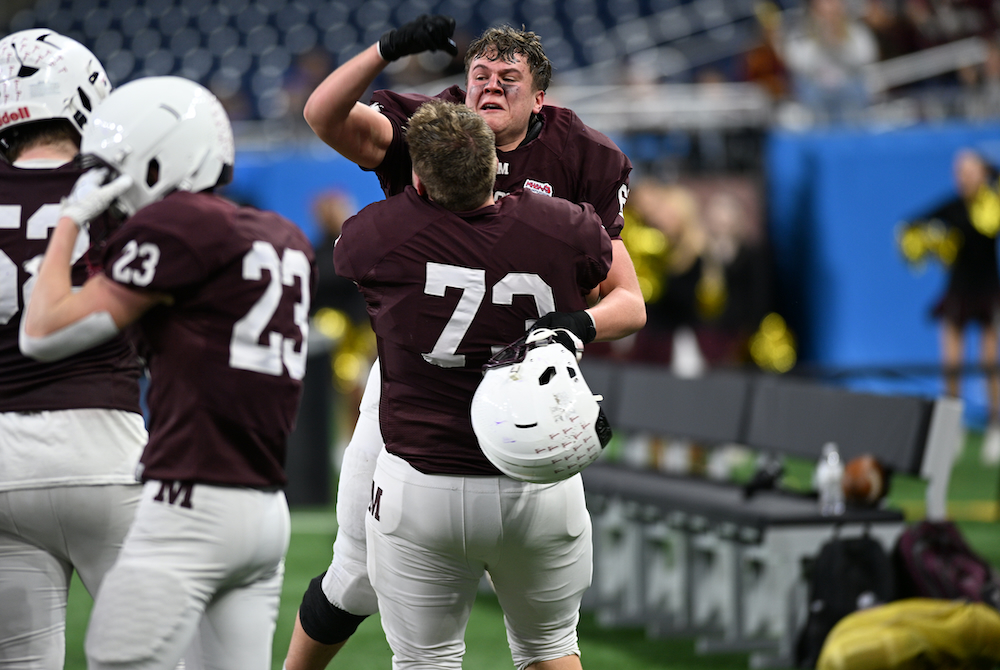
Menominee Caps Powerful Ford Field Return with 1st Championship Since 2007
By
Scott DeCamp
Special for MHSAA.com
November 30, 2025
DETROIT – Menominee’s football program has been known a long time for its single-wing offensive scheme, which certainly has served the Maroons well over the years.
The secret to their success goes way deeper than that, however, and it has nothing to do with X’s and O’s. Call it grit, tenacity, resolve – the Maroons have built their program around those characteristics – and now they’re back on top.
Menominee defeated Schoolcraft, 34-6, in the Division 7 Final on Sunday at Ford Field, where the word “grit” has been stamped into the fabric of the Detroit Lions by head coach Dan Campbell.
With a comprehensive effort, Menominee (14-0) captured its first Finals title since 2007, the fourth in program history, and the first for an Upper Peninsula 11-player football team since Ishpeming claimed the Division 7 championship in 2015.
“Just grit and just hard work. I mean, you saw it out there, we’ve got 30 guys on our sideline. Growing up in Menominee, you’re going to have 30 guys on your team, if that,” said Menominee senior Tanner Theuerkauf, starting quarterback and safety.
“You look at our offensive line, we have our guard, he’s 150 pounds – you don’t ever see that, and he just does his job and all those guys do their job in the trenches. … Our want to win is just something you don’t see.”
Theuerkauf and some of his teammates were part of Menominee’s Division 7 runner-up squad two years ago, when the Maroons battled powerhouse Jackson Lumen Christi but fell just short, 34-30.
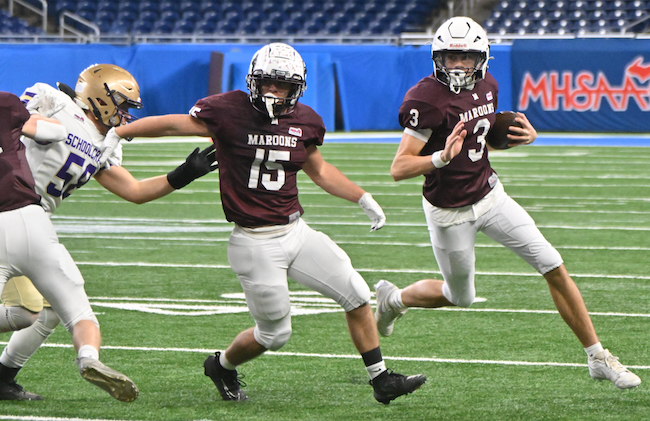 In last week’s Semifinal, Menominee showed great resolve in erasing a two-touchdown deficit in the fourth quarter and securing a 32-28 victory over Pewamo-Westphalia in a matchup of teams ranked Nos. 1 and 2, respectively, in the final regular-season Division 7 poll.
In last week’s Semifinal, Menominee showed great resolve in erasing a two-touchdown deficit in the fourth quarter and securing a 32-28 victory over Pewamo-Westphalia in a matchup of teams ranked Nos. 1 and 2, respectively, in the final regular-season Division 7 poll.
“Different mentality this year with these seniors,” said fourth-year Menominee coach Chad Brandt, who coincidentally did his student-teaching at Schoolcraft starting in 1996. “Times that I’m not around and they’re running to the locker room and grabbing the footballs and I drive by and they’re out there. That means a lot. And we have linemen that text me, ‘Can we have extra weight-room sessions?’ and those kind of things.
“It takes a lot of work, and these guys have put it in and I just couldn’t be prouder of this group of guys and for our town and for our school of Menominee because they deserve and they appreciate it and they support us in every way possible.”
Menominee senior Clayton Miller helped set the tone Sunday with his hard-nosed running. The 5-foot-11, 190-pounder scored the first three TDs of the game for the Maroons, who took a 7-0 lead on his five-yard run less than four minutes into the contest, went up 13-0 on his two-yard run midway through the second, and led 20-0 on his 31-yard sprint four minutes into the third quarter.
Miller finished with a game-high 112 rushing yards on 25 carries.
“He’s the greatest running back that I’ve ever played with. He’s one of the greatest in Menominee history,” Theuerkauf said about Miller. “He’s not the biggest guy in the world, but he just runs so hard – he runs through guys. … Just for him to want to win, he shows so much energy out there. He’s not the most talkative guy, but he gets the job done and I love that.”
Several Menominee players got the job done, but senior Maverick Geniesse was another who stood out. With Menominee leading 7-0 late in the first quarter and Schoolcraft threatening to score, Geniesse intercepted a pass at the 1 on a Schoolcraft first-and-10 from the 12 to snuff out the Eagles’ opportunity.
Menominee embarked on an 18-play, 79-yard drive that chewed up 8:17 of the clock and was capped by Miller’s second TD run as the Maroons took command with a 13-0 lead.
Geniesse also got into the scoring act, catching a two-yard TD toss from Theuerkauf early in the fourth quarter for a 28-0 Maroons lead. Junior Jackson Myszak capped the Menominee scoring with an eight-yard TD run with 2½ minutes left.
“It feels great. I mean, I’ve dreamed about stuff like this. The ultimate goal is to just be the best team player I can and help the team in any way I can,” Geniesse said. “Of course, the interception, that got our morale going the other way; and the touchdown (reception), it felt pretty good.”
Schoolcraft (11-3) got on the board midway through the fourth quarter on senior TJ Luteyn’s four-yard scoring run.
Both teams displayed offensive balance – Menominee was just more effective throughout the game. Menominee tallied 358 total yards (198 rushing, 160 passing), while Schoolcraft totaled 248 (100 rushing, 148 passing).
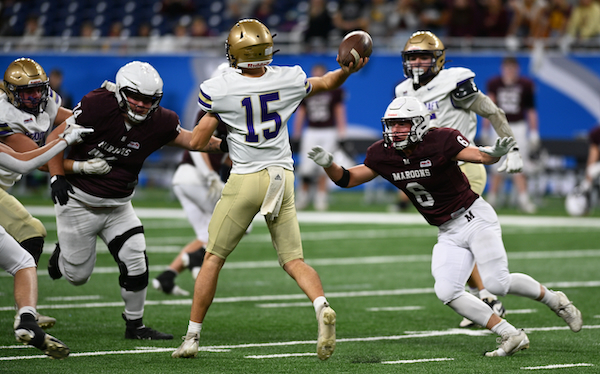 “Good, physical team,” Schoolcraft first-year coach Dan DeVries said about Menominee. “Their scheme is a challenging scheme. They can hit the edge hard and you’ve also got to watch for something up the middle and their quarterback can throw as well, so a lot of dimensions to their game. I think they played a fantastic game today. They didn’t make mistakes and we did, and that certainly showed in the score.”
“Good, physical team,” Schoolcraft first-year coach Dan DeVries said about Menominee. “Their scheme is a challenging scheme. They can hit the edge hard and you’ve also got to watch for something up the middle and their quarterback can throw as well, so a lot of dimensions to their game. I think they played a fantastic game today. They didn’t make mistakes and we did, and that certainly showed in the score.”
Theuerkauf completed passes to six receivers and finished 7-of-11 for 160 yards. Schoolcraft junior QB Jack DeVries was 12-for-26 for 148 yards.
Schoolcraft seniors Evan Feller and Dane Ostlund paced all defenders with 12 and 11 tackles, respectively. Junior Nathan Nelson notched nine tackles to lead Menominee.
Going back to the late-1980s, Schoolcraft has been a small-school football power, but Sunday marked the Eagles’ first Finals appearance since 2001. They’ve made seven Finals appearances overall and captured titles in 1988, 1989, and 2001.
“Just to see the support and what it means to the town and stuff like that after 24 years – I mean, that’s a long time to not make it back after we’ve had a history of having good football teams and stuff like that,” Jack DeVries said.
“It’s great to do it with the group of seniors we have. Great group of guys – been playing with them for as long as we can remember. (We’ve been) talking about (Ford Field) since we were kids, and getting to go do it was a special thing.”
Sunday signified Menominee’s seventh Finals appearance overall as well. The Maroons also seized championships in 1998, 2006, and 2007 under legendary coach Ken Hofer.
This Menominee teamed restored some of that “UP Power” that Maroons and others north of the Mackinac Bridge take such great pride in.
“That does mean something when we head back across that bridge and it’s ‘UP Power’ and we’ll go through other towns and they’ll be honking horns or happy out on the street …,” said Brandt, a Gladstone native, who spent 20 years as head coach at Stephenson in the UP.
“The UP is someplace special, and it means something.”
For Theuerkauf, this one was a bit personal, too. His older brother, Trevor Theuerkauf, was the starting QB and a two-way standout on the Menominee team that made it to the Finals in 2023.
“He just told me, ‘Go out there and play (your) game. (You) don’t have to worry about anything else,’” Tanner Theuerkauf said. “I kind of had the edge on some of these guys because I’ve been here before. I played in this game – didn’t go our way, but today, come out and get the job done, it’s just the greatest feeling of my life.”
PHOTOS (Top) Menominee’s Brayden Daigneau (73) hoists a teammate into the air Sunday as they celebrate their team’s Division 7 title. (Middle) Tanner Theuerkauf (3) follows Clayton Miller (15) around the edge. (Below) The Maroons’ Jackson Myszak (6) puts pressure on Schoolcraft quarterback Jack DeVries.

